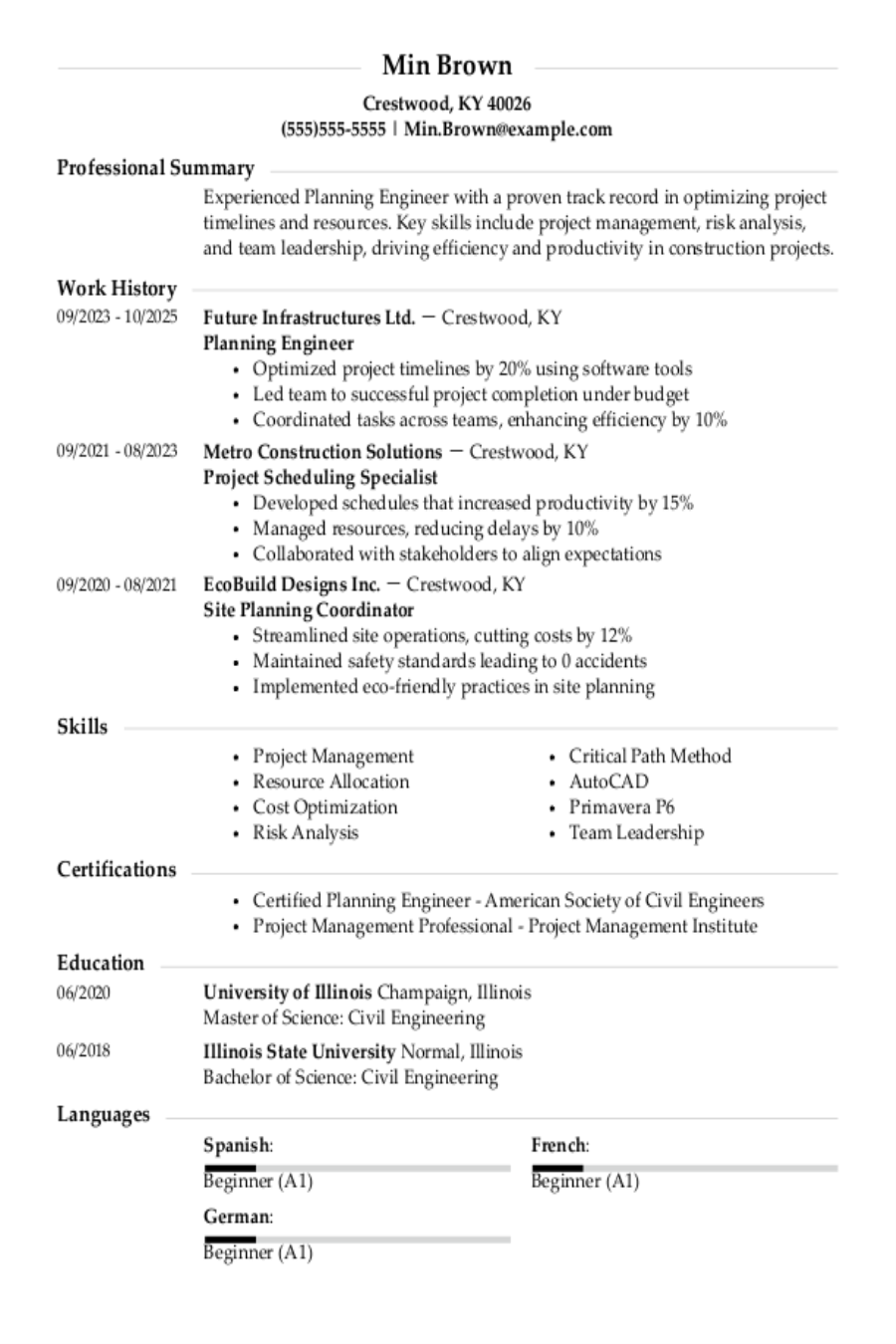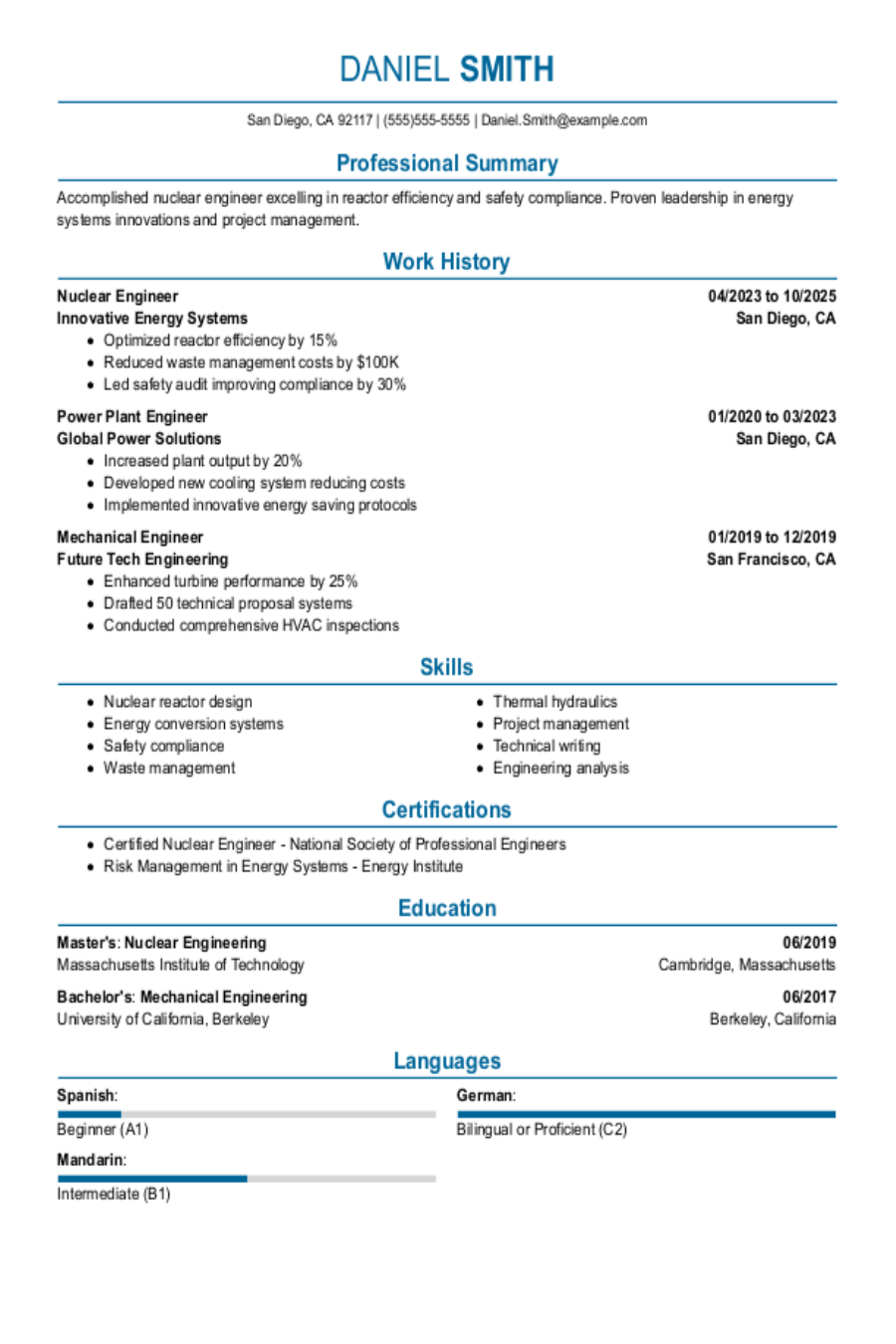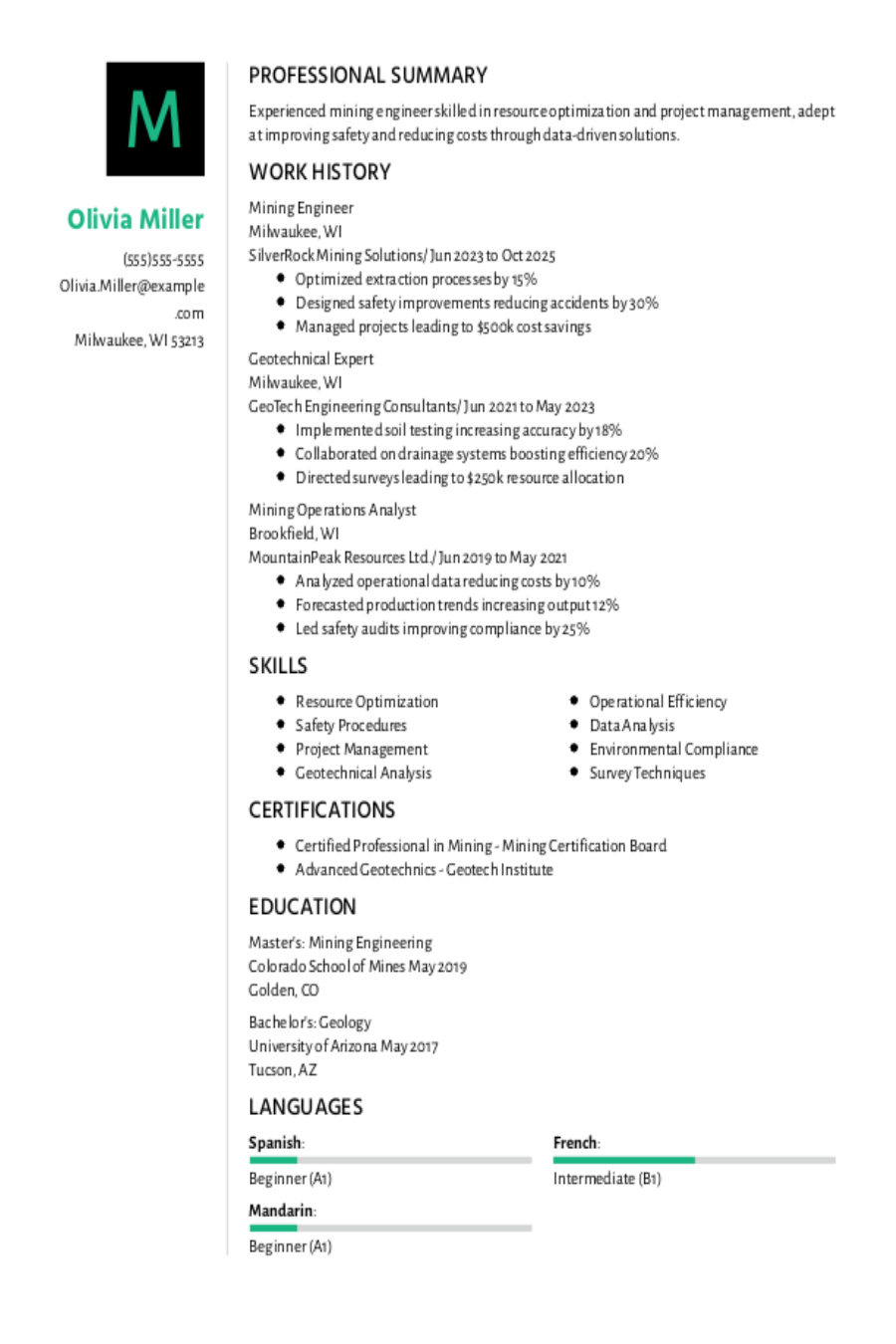Table of contents
Popular Environmental Engineer Resume Examples
Entry-level environmental engineer resume
An entry-level resume for an environmental engineer should highlight relevant academic projects, internships, certifications, and technical skills such as data analysis and problem-solving to demonstrate capability.
Emphasizes soft skills: This resume highlights the job seeker's strong project management and analytical skills, which compensate for limited experience.
Showcases education: This resume boosts the candidate’s credibility by featuring their education near the top of the document.
Mid-career environmental engineer resume
A mid-career environmental engineer resume should emphasize a strong combination of project experience, technical skills, and continuous professional development to effectively demonstrate expertise and growth in the field.
Includes mix of skills: This resume effectively highlights the applicant's technical expertise in environmental engineering alongside their leadership and teamwork skills, demonstrating a well-rounded professional capable of driving compelling sustainability initiatives.
Encourages quick scanning: A clean and structured layout allows hiring managers to quickly identify key qualifications and accomplishments, ensuring the applicant’s expertise in environmental engineering stands out effectively.
Experienced environmental engineer resume
An experienced environmental engineer resume should highlight key projects and results that demonstrate technical expertise and contributions to sustainable practices in a clear and organized manner.
Follows traditional format: The chronological resume format clearly outlines the extensive experience of the job seeker, enabling them to effectively illustrate their career progression and achievements across various roles in environmental engineering.
Optimized for ATS: The resume uses a clear and professional template that seamlessly integrates an engaging header with an ATS-friendly resume structure, improving visibility for both recruiters and automated systems.
No experience environmental engineer resume
A resume for an applicant with no experience should highlight relevant coursework, technical skills, and any volunteer work or internships that reflect a commitment to sustainability and environmental protection.
Favors clarity over complexity: The resume's clean design effectively highlights qualifications through clear sections and concise descriptions, ensuring the focus remains on relevant skills and experiences.
Leads with education: Incorporating academic accomplishments in the accomplishments section and featuring their degrees prominently helps boost this candidate's credibility despite limited experience.
Environmental Engineer Resume Template
Looking to create a standout application? Use this professional environmental engineer resume template as your foundation—simply copy and customize it with your own details.
Aiko Yamamoto
San Diego, CA 92102
(555)555-5555
Aiko.Yamamoto@example.com
Professional Summary
Results-driven Environmental Engineer with 4 years experience. Expertise in sustainability, waste management, and lowering emissions. Proven track record of improved efficiency and compliance in eco-friendly initiatives.
Work History
Environmental Engineer
EcoTech Innovations - San Diego, CA
July 2022 - October 2025
- Reduced emissions by 20% via new processes
- Led project team boosting efficiency by 15%
- Improved waste recycling rates by 30%
Environmental Analyst
Green Earth Solutions - San Francisco, CA
January 2020 - June 2022
- Analyzed data improving compliance 12%
- Developed reports reducing costs by 10%
- Implemented monitoring systems saving $50k
Sustainability Consultant
Renewable Innovations Group - San Diego, CA
January 2019 - December 2019
- Conducted audits cutting waste by 25%
- Designed eco-friendly plans increasing ROI 18%
- Educated staff boosting awareness by 40%
Skills
- Environmental Impact Assessment
- Sustainable Development
- Waste Management
- Renewable Energy Solutions
- Data Analysis
- Project Management
- Regulatory Compliance
- Pollution Control
Education
Master's Degree Environmental Engineering
University of California, Berkeley Berkeley, California
June 2019
Bachelor's Degree Civil Engineering
Oregon State University Corvallis, Oregon
June 2017
Certifications
- Certified Environmental Engineer - National Environmental Certification Board
- LEED Accredited Professional - Green Building Certification Institute
Languages
- Spanish - Beginner (A1)
- German - Intermediate (B1)
- Mandarin - Beginner (A1)
Writing Your Environmental Engineer Resume
Having explored these effective resume examples, you're all set to dive into how to write a resume. We'll walk you through each part, ensuring you understand every detail.
List your most relevant skills
An effective skills section for your environmental engineer resume should include both technical skills, such as knowledge of environmental regulations and skill in software tools, along with soft skills like analytical thinking and teamwork. Highlighting these skills not only demonstrates your readiness for the role but also makes it easier for recruiters to see how you fit into their needs.
Remember to incorporate keywords from the job listing into your skills section. This strategy helps you connect with human readers by showing that you understand the position's requirements while also improving your chances of passing through applicant tracking systems. Tailoring this section can significantly increase your visibility as a qualified applicant in a competitive field.
Example of skills on an environmental engineer resume
- Proficient in environmental impact assessments and regulatory compliance
- Strong analytical skills with expertise in data interpretation
- Collaborative team player committed to sustainable solutions
- Excellent project management abilities with a focus on safety
Highlighting soft skills on your resume can set you apart from other applicants. Employers greatly appreciate interpersonal abilities since they are challenging to develop. Showcasing these traits can demonstrate your potential as a valuable team member.
Highlight your work history
Your work experience section must demonstrate how you apply your expertise in real-world scenarios. Focus on showcasing specific projects or initiatives where you've made a significant impact, ensuring that each entry is packed with relevant keywords to catch the eye of hiring managers.
For each job entry, be sure to include essential details such as your job title, the employer's name, and the dates you were employed. This information helps employers quickly assess your background and credibility. Don't shy away from quantifying your accomplishments—data-driven results can make a compelling case for your skills and experiences.
Example of an environmental engineer work experience entry
- Environmental Engineer
Green Solutions Inc. - San Diego, CA
June 2019 - Present - Design and implement innovative waste management systems that reduced landfill contributions by 30% annually
- Conduct environmental impact assessments for new projects, ensuring compliance with local and federal regulations
- Collaborate with cross-functional teams to develop sustainable practices, leading to a 15% decrease in operational costs
- Mentor junior engineers on environmental modeling techniques and project management best practices, improving team productivity by 25%
- Present findings to stakeholders, effectively communicating complex data and fostering community engagement in sustainability initiatives
Highlighting outcomes and achievements in your experience section is important because it demonstrates the real-world impact of your work. Employers are interested in the results you’ve achieved, such as cost savings or improved efficiency, rather than just the duties you performed. This approach showcases your ability to make a meaningful contribution, making you a more compelling applicant.
Include your education
The education section of your environmental engineer resume should list your degrees and diplomas in reverse-chronological order starting with the most recent qualification. Include any bachelor's degree or higher while omitting your high school diploma if you have advanced education. Highlight relevant coursework, honors, or projects that showcase your expertise in environmental engineering.
For those currently pursuing a degree or who have incomplete education, list the highest level achieved along with an expected graduation date. Improve this section by including bullet points that detail relevant coursework or significant academic achievements demonstrating your preparedness for the field. This strategy is especially effective for students or recent graduates wanting to emphasize their academic background.
Common certifications for an environmental engineer resume
- Leadership in Energy and Environmental Design (LEED) – U.S. Green Building Council
- Certified Environmental Professional (CEP) – Academy of Board Certified Environmental Professionals
- Project Management Professional (PMP) – Project Management Institute
- Environmental Engineer-in-Training (EIT) – National Council of Examiners for Engineering and Surveying
Sum up your resume with an introduction
Creating a compelling profile section on your resume is important for making a strong first impression. This section serves as your introduction to potential employers, encapsulating your qualifications and career focus in a concise manner. .
For experienced job seekers, a professional summary is highly effective as it showcases your significant accomplishments and relevant skills right at the top. If you’re entering the workforce, try adding a resume objective that highlights your commitment to progressing in your career.
Professional summary example
Dynamic environmental engineer with over 10 years of experience in sustainable design and water resource management. Demonstrated success in leading interdisciplinary projects that reduce environmental impact while improving efficiency. Expertise in regulatory compliance, environmental assessments, and innovative remediation strategies.
Resume objective example
Enthusiastic environmental engineer eager to use a solid foundation in sustainable design and project management to support innovative environmental solutions. Committed to applying analytical thinking and teamwork skills to contribute effectively to projects that improve ecological health and promote sustainability.
As an environmental engineer, your resume profile plays a key role in making a strong first impression. It's the ideal spot to incorporate relevant keywords from job descriptions, boosting your chances of navigating applicant tracking systems successfully. Craft your introduction with targeted qualifications that align closely with the role to improve visibility and capture attention early.
Add unique sections to set you apart
Incorporating optional resume sections can significantly improve your application as an environmental engineer. These segments allow you to highlight your unique qualifications and make a memorable impression on employers.
These sections provide an opportunity to showcase various aspects of your professional persona. You can include relevant hobbies that align with sustainability or conservation efforts, as well as volunteer work that reflects your commitment to environmental causes. By sharing these experiences, you not only demonstrate your skills but also convey your values and working style, making you a standout applicant in the field of environmental engineering.
Three sections perfect for a environmental engineer resume
- Technical Skills: As an environmental engineer, showcasing your technical skills is essential. They demonstrate your expertise in critical areas and can set you apart from other applicants.
- Tools and Platforms: In today's environmental engineering field, showcasing your computer skills is essential. Highlight your experience with modeling programs, data analysis platforms, and project management software to demonstrate your technical capabilities and improve project outcomes.
- Professional Certifications: Certifications highlight your dedication to professional growth in technical fields. Pursue relevant certifications to improve your skills and stand out in the competitive job market.
5 Resume Formatting Tips
- Choose a format that matches your career stage.
Selecting the right resume format is important for showcasing your skills effectively. If you’re an established professional, a chronological format highlights your experience best. For those new to the field, consider a functional resume to emphasize transferable skills. A combination format can also serve well if you have both relevant experience and skills to showcase.
- Pick a smart resume template.
To improve the readability of your resume, consider using a professional resume template. A well-structured format not only makes your information easy to digest but also helps you present your qualifications effectively. If you opt for a custom design, ensure it remains clean and compatible with ATS standards.
- Select an appropriate font.
Choose a professional font such as Helvetica, Georgia, or Verdana to ensure clarity for both ATS and hiring managers.
- Use consistent formatting.
Align your resume to the left and maintain uniform margins for a clean, professional look that improves readability and gives a polished impression.
- Keep your resume to one or two pages.
When crafting your resume, remember that resumes should be one page long unless you have extensive experience. Focus on keeping content concise and relevant to ensure that hiring managers quickly see your strengths.
What’s the Average Environmental Engineer Salary?
Environmental engineer salaries vary based on location, career level, and qualifications.
This data, provided by the Bureau of Labor Statistics, will show you expected salary ranges for environmental engineers in the top 5 highest-paying states, including the District of Columbia. The figures reflect the most current salary data available, collected in 2024.
- Full Range
- Most Common (25th–75th percentile)
- Average
Oregon
Most common: $105,980 - $140,590
California
Most common: $100,680 - $147,100
Louisiana
Most common: $94,880 - $150,780
Illinois
Most common: $84,610 - $126,190
District of Columbia
Most common: $102,500 - $137,610
Tools for Your Job Search
Are you ready to advance your career as an environmental engineer? Before you submit your application for that exciting position, consider using our ATS Resume Checker. This essential tool provides insights into how well your resume stands up against the automated systems many companies use for initial screenings.
Looking to further improve your resume? Our AI Resume Builder offers tailored recommendations specifically designed for your engineering background. It includes professional templates that effectively showcase your skills and projects to potential employers.
Frequently Asked Questions
Last Updated: October 9, 2025
Absolutely. A cover letter is important because it adds depth to your resume and provides a platform for you to connect with potential employers. It’s your chance to highlight why this role in environmental engineering excites you and how your specific skills and experiences make you the ideal job seeker. So, don’t hesitate—write a cover letter that improves your application.
For a quick and effective solution, try our AI Cover Letter Generator. It allows you to create tailored cover letters in just minutes! Plus, you can choose from various cover letter template options that match your resume perfectly, ensuring a polished and professional presentation of your qualifications.
A resume is typically a concise document that spans one to two pages, summarizing your skills and experience. In contrast, a CV (curriculum vitae) can extend several pages, providing in-depth details about your academic background, research contributions, publications, and extensive professional experience.
You should use a CV for roles in academia or specialized fields like environmental engineering, where detailed qualifications are important. If you're unsure whether to create a resume or CV for your next application, our online CV Maker is here to help! With various CV templates tailored for different industries and career levels, you can quickly craft an impressive CV that showcases your expertise effectively.
An environmental engineer's resume should typically be one page long, showcasing relevant skills and experiences concisely. However, seasoned professionals with extensive qualifications may opt for a two-page resume format to highlight their comprehensive background effectively.
Practice answering job interview questions and answers to boost your confidence. Being well-prepared not only helps you articulate your thoughts clearly but also equips you to handle any surprises that may arise during the interview.
When crafting your resume as an environmental engineer, you can briefly state your career aspirations. However, to provide depth, elaborate on these goals in your cover letter. Aim for positions that not only align with your current skills but also offer opportunities for growth and advancement in the field of environmental engineering.
To advance as an environmental engineer, actively pursue upskilling through certifications and specialized courses. Engage with industry associations to network and stay informed about the latest trends. Regularly read relevant publications and participate in webinars to deepen your expertise and improve your professional growth.
Was this information helpful? Let us know!
Hailey is a career advice writer dedicated to helping job seekers excel in their careers.
More resources

The Most Dangerous Jobs in America: Some Pay Less Than $40K, Others Top $190K
Resume Now s report reveals the highest and lowest paying dang...

How to Write a Resume: Guide & Examples for 2025
If you re wondering how to write a resume that grabs attenti...

Still in the Game: 9 in 10 Older Workers Are Upskilling to Stay Competitive
The idea that older workers are resistant to change doesn t ho...




